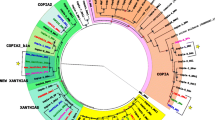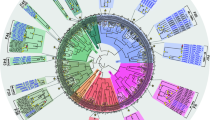Abstract
Horizontal transfer in Drosophila has been inferred for several families of transposable elements. Specifically, the retroelement roo has been suggested to have been horizontally transferred between the species D. melanogaster, D. simulans, D. sechellia and D. yakuba. The inferences were based on the observation that divergence between transposable elements in different species was lower than the divergence found in typical nuclear genes and in the incongruence of phylogenies of the species and their TEs. Here, we address the question of the possible horizontal transfer of roo between species of the Drosophila genus by studying the presence absence of a duplication of 99 bp in the 5’UTR of the transposon, as well as comparing the sequences of the paralogous and orthologous duplicated repeats within and between species. First, the repeats were only found in five species of the melanogaster subgroup. Second, the date of occurrence of the duplication event originating the repeats was posterior to the split of the subgroup. The duplication date suggests an origin previous to the split of D. simulans and D. sechellia and close to the divergence of D. melanogaster from the D. simulans complex. These data point to horizontal transfer to the afrotropical species D. yakuba and D. erecta from one of the cosmopolitan species D. melanogaster or D. simulans. We propose that the parasitoid wasp Leptopilina could have been the vector of horizontal transfer after the observation that a sequence of 845 bp with high homology to a fragment of roo was isolated from this wasp.


Similar content being viewed by others
Data availability
Every reference to data are provided.
References
Bartolomé C, Bello X, Maside X (2009) Widespread evidence for horizontal transfer of transposable elements across Drosophila genomes. Genome Biol 10:R22
Bargues N, Lerat E (2017) Evolutionary history of LTR-retrotransposons among 20 Drosophila species. Mob DNA 8:7
Bowen NJ, McDonald JF (2001) Drosophila euchromatic LTR retrotransposons are much younger than the host species in which they reside. Genome Res 11:1527–1540
Carton Y, Bouletreau M, van Alphen JJM, van Lenteren JC (1986) The Drosophila parasitic wasps. In: Ashburner M, Carson L, Thompson JN (eds) The genetics and biology of Drosophila. Academic Press, London, pp 347–394
Cutter AD (2008) Divergence times in Caenorhabditis and Drosophila inferred from direct estimates of the neutral mutation rate. Mol Biol Evol 25:778–786
De la Chaux N, Wagner A (2009) Evolutionary dynamics of the LTR retrotransposons roo and rooA inferred from twelve complete Drosophila genomes. BMC Evol Biol 9:205
Díaz-González J, Domínguez A, Albornoz J (2010) Genomic distribution of retrotransposons 297, 1731, copia, mdg1 and roo in the Drosophila melanogaster species subgroup. Genetica 138:579–586
Díaz-González J, Domínguez A, Albornoz J (2020) Different structural variants of roo retrotransposon are active in Drosophila melanogaster. Gene 741:144546
Felsenstein J (1985) Confidence-limits on phylogenies - an approach using the bootstrap. Evolution 39:783–791
Houck MA, Clark JB, Peterson KR, Kidwell MG (1991) Possible horizontal transfer of Drosophila genes by the mite Proctolaelaps regalis. Science 253:1125–1128
Kaminker JS, Bergman CM, Kronmiller B, Carlson J, Svirskas R, Patel S, Frise E, Wheeler DA, Lewis SE, Rubin GM, Ashburner M, Celniker SE (2002) The transposable elements of the Drosophila melanogaster euchromatin: a genomics perspective. Genome Biol 3:1–20
Keightley PD, Trivedi U, Thomson M, Oliver F, Kumar S, Blaxter ML (2009) Analysis of the genome sequences of three Drosophila melanogaster spontaneous mutation accumulation lines. Gnome Res 19:1195–1201
Kidwell MG (1992) Horizontal transfer. Curr Opin Genet Dev 2:868–873
Kumar S, Stecher G, Tamura K (2016) MEGA7: molecular evolutionary genetics analysis version 7.0 for bigger datasets. Mol Biol Evol 33:1870–1874
Lerat E, Rizzon C, Biemont C (2003) Sequence divergence within transposable element families in the Drosophila melanogaster genome. Genome Res 13:1889–1896
Li W (1997) Molecular evolution. Sinauer, Sunderland
Loreto ELS, Carareto CM, Capy P (2008) Revisiting horizontal transfer of transposable elements in Drosophila. Heredity 100:545–554
Mérel V, Boulesteix M, Fablet M, Vieira C (2020) Transposable elements in Drosophila. Mob DNA 11:23
Milan NF, Schlenke TA (2012) Extensive horizontal gene transfer between Drosophila melanogaster and its endoparasitoid wasps. Unpublished. GenBank JQ666319
Modolo L, Picard F, Lerat E (2014) A new genome-wide method to track horizontally transferred sequences: application to Drosophila. Genome Biol Evol 6:416–432
Obbard DJ, Maclennan J, Kim KW, Rambaut A, O’Grady PM, Jiggins FM (2012) Estimating divergence dates and substitution rates in the Drosophila phylogeny. Mol Biol Evol 29:3459–3473
Rambaut A (2006) FigTree: tree figure drawing tool, version 1.4.2. Institute of evolutionary biology. University of Edinburgh, Edinburgh
Sánchez-Gracia A, Maside X, Charlesworth B (2005) High rate of horizontal transfer of transposable elements in Drosophila. Trends Genet 21:200–203
Tamura K, Subramanian S, Kumar S (2004) Temporal patterns of fruit fly (Drosophila) evolution revealed by mutation clocks. Mol Biol Evol 21:36–44
Thurmond J, Goodman JL, Strelets VB, Attrill H, Gramates LS, Marygold SJ, Matthews BB, Millburn G, Antonazzo G, Trovisco V, Kaufman TC, Calvi BR, the FlyBase Consortium (2019) FlyBase 2.0: the next generation. Nucleic Acids Res 47(D1):D759–D765
Acknowledgements
I thank Fernando Rodríguez for his critical reading of the manuscript and Sara de Albornoz for the correction and improvement of my English.
Funding
Not applicable.
Author information
Authors and Affiliations
Corresponding author
Ethics declarations
Conflict of interest
The author declare that she has no conflict of interests.
Additional information
Publisher's Note
Springer Nature remains neutral with regard to jurisdictional claims in published maps and institutional affiliations.
Supplementary Information
Below is the link to the electronic supplementary material.
Rights and permissions
About this article
Cite this article
Domínguez, A. Interrogating the 5’UTR tandem repeats of retrotransposon roo of Drosophila about horizontal transfer. Genetica 149, 171–177 (2021). https://doi.org/10.1007/s10709-021-00120-y
Received:
Accepted:
Published:
Issue Date:
DOI: https://doi.org/10.1007/s10709-021-00120-y





